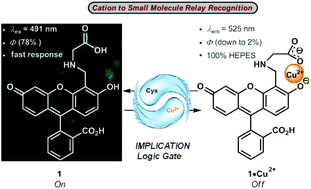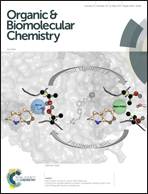A fluorescein-based chemosensor for relay fluorescence recognition of Cu(ii) ions and biothiols in water and its applications to a molecular logic gate and living cell imaging†
Abstract
Relay recognition of copper(II) ions and biothiols via a fluorescence “on–off–on” cascade was designed and realized as a new sequential combination of cations and small molecules. Probe 1 bearing a fluorescein skeleton was thus synthesized, which performed well in 100% HEPES buffer (pH = 7.0) solution, as a highly sensitive, selective fluorescence sensor for Cu2+. The limit of detection (LOD, 0.017 ppm) was obtained, and this value is much lower than 1.3 ppm, allowed by US EPA. The 1 : 1 complex generated from fast sensing of Cu2+ when excited at 491 nm, showed good relay recognition for biothiols (i.e., Cys, Hcy and GSH with low detection limits of 0.12 μM, 0.036 μM and 0.024 μM, respectively) via remarkable fluorescence enhancement. The origin of this relay process was disclosed through ESI-MS and corresponding density functional theory (DFT) computations. Notably, probe 1 can be utilized for the construction of a molecular logic gate with the IMPLICATION function by using the above fluorescence changes. Moreover, this relay recognition was also applied to HepG2 cell imaging successfully.

- This article is part of the themed collection: Chemosensors and Molecular Logic


 Please wait while we load your content...
Please wait while we load your content...